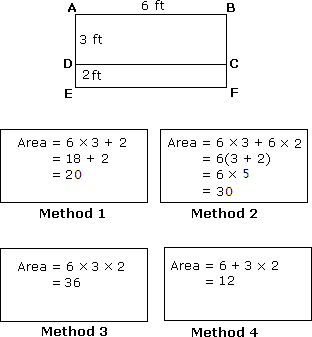Solved Examples and Worksheet for Using Distributive Property to Solve Problems
A. 4(
B. 4(
C. 4(
D. 4(
Step: 1
Distributive property states that the product of a number and a sum is equal to the sum of the individual products of addends and the number.
a b c ab ac
Step: 2
From the given choices "4(x x
Correct Answer is : 4(x x
A. 4(
B. 4(
C. 4(
D. 4(
Step: 1
Distributive property states that the product of a number and a sum is equal to the sum of the individual products of addends and the number.
a b c ab ac
Step: 2
From the given choices " 4(x x
Correct Answer is : 4(x x
A. Additive Identity Property
B. Distributive Property
C. Associative Property of Addition
D. Commutative Property of Addition
Step: 1
[Given expression.]
Step: 2
In the expression the product of a number and a sum is same as the sum of the individual products of addends and the number.
Step: 3
Distributive property states that the product of a number and a sum is equal to the sum of the individual products of addends and the number.
Step: 4
So, the property 'Distrubitive Property' is illustrated in the given equation.
Correct Answer is : Distributive Property

A. Method 3
B. Method 4
C. Method 1
D. Method 2
Step: 1
Distributive property states that the product of a number and a sum is equal to the sum of the individual products of addends and the number.
Step: 2
Among the methods, Method 2 illustrates the sum of individual products of addends and the number.
[Given that Andrea used distributive property to solve the area of the rectangle ABFE.]
Step: 3
So, Method 2 shows Andrea's steps.
Correct Answer is : Method 2
A. (14 × 10) + (14 ×
B. 14 + 10 ×
C. 14 ×
D. 14 × 10 +
Step: 1
Area of the room = length × width = 14 × 10 5 12
Step: 2
14 × 10 5 12 5 12
[10 5 12 5 12]
Step: 3
= (14 × 10) + (14 × 5 12
[Using distributive property.]
Step: 4
Using distributive property we can write 14 × 10 5 12 5 12
Correct Answer is : (14 × 10) + (14 × 5 12
A. (
B. (
C. (
D. (
Step: 1
Distributive property is a b c a b a c a b c
Step: 2
= (2 3 7 9 2 3 3 5
Correct Answer is : (2 3 7 9 2 3 3 5
A. 16 × 12 +
B. 16 ×
C. 16 + 12 ×
D. (16 × 12) + (16 ×
Step: 1
Area of George's lawn = length × width = 16 × 121 2
Step: 2
16 × 121 2 1 2
Step: 3
= (16 × 12) + (16 × 1 2
[Using distributive property.]
Step: 4
Using distributive property we can write 16 × 121 2 1 2
Correct Answer is : (16 × 12) + (16 × 1 2
- Evaluating Numerical Expressions-Gr 6-Solved Examples
- Evaluating Algebraic Expressions-Gr 6-Solved Examples
- Understanding and Writing Algebraic Expressions-Gr 6-Solved Examples
- Describing Change in One Variable Affecting the Other-Gr 6-Solved Examples
- Identifying Dependent and independent Variables for the Situations-Gr 6-Solved Examples
- Solving Linear Equations-Gr 6-Solved Examples
- Writing Linear Equations for the Situations-Gr 6-Solved Examples
- Applications of Linear Equations-Gr 6-Solved Examples
- Solving One Step Inequalities-Gr 6-Solved Examples
- Writing Inequalities Representing the Relationships-Gr 6-Solved Examples
Related Worksheet
- Rate